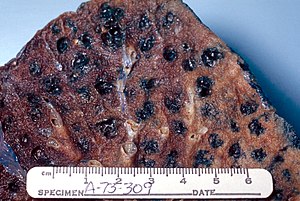Chronic obstructive pulmonary disorder
| Chronic obstructive pulmonary disease | |
|---|---|
| Synonyms | Chronic obstructive lung disease (COLD), chronic obstructive airway disease (COAD), chronic bronchitis, emphysema, pulmonary emphysema, others |
 |
|
| Gross pathology of a lung showing centrilobular-type emphysema characteristic of smoking. This close-up of the fixed, cut lung surface shows multiple cavities filled with heavy black carbon deposits. | |
| Specialty | Pulmonology |
| Symptoms | Shortness of breath, cough with sputum production. |
| Complications | Acute exacerbation of chronic obstructive pulmonary disease |
| Usual onset | Over 40 years old |
| Duration | Long term |
| Causes | Tobacco smoking, air pollution, genetics |
| Diagnostic method | Lung function tests |
| Differential diagnosis | Asthma |
| Prevention | Improving indoor and outdoor air quality |
| Treatment | Stopping smoking, respiratory rehabilitation, lung transplantation |
| Medication | Vaccinations, inhaled bronchodilators and steroids, long-term oxygen therapy |
| Frequency | 174.5 million (2015) |
| Deaths | 3.2 million (2015) |
| Classification |
· ·
|
|---|---|
| External resources |
Chronic obstructive pulmonary disease (COPD) is a type of obstructive lung disease characterized by long-term breathing problems and poor airflow. The main symptoms include shortness of breath and cough with sputum production. COPD is a progressive disease, meaning it typically worsens over time. Eventually everyday activities, such as walking or getting dressed, become difficult.Chronic bronchitis and emphysema are older terms used for different types of COPD. The term "chronic bronchitis" is still used to define a productive cough that is present for at least three months each year for two years.
Tobacco smoking is the most common cause of COPD, with factors such as air pollution and genetics playing a smaller role. In the developing world, one of the common sources of air pollution is poorly vented heating and cooking fires. Long-term exposure to these irritants causes an inflammatory response in the lungs, resulting in narrowing of the small airways and breakdown of lung tissue. The diagnosis is based on poor airflow as measured by lung function tests. In contrast to asthma, the airflow reduction does not improve much with the use of a bronchodilator.
Most cases of COPD can be prevented by reducing exposure to risk factors. This includes decreasing rates of smoking and improving indoor and outdoor air quality. While treatment can slow worsening, no cure is known. COPD treatments include stopping smoking, vaccinations, respiratory rehabilitation, and often inhaled bronchodilators and steroids. Some people may benefit from long-term oxygen therapy or lung transplantation. In those who have periods of acute worsening, increased use of medications and hospitalization may be needed.
...
Wikipedia
